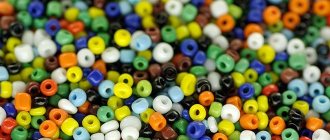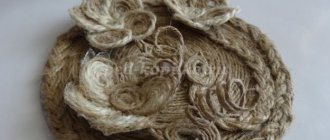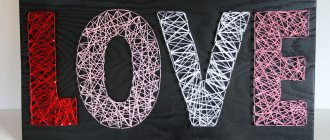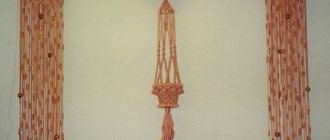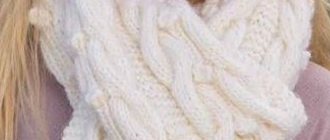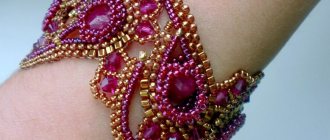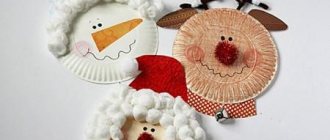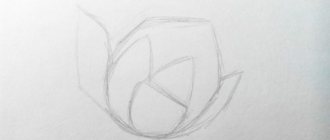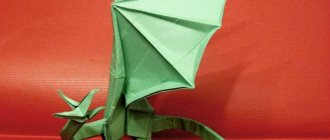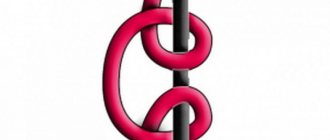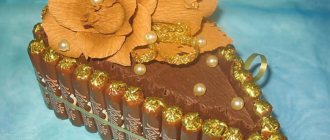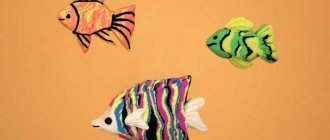Want to learn cross stitch? We will help! Before typing the coveted “cross stitch patterns” into a search engine, let’s figure out where to start and what materials to choose, what methods and styles of embroidery exist and which of them are most suitable for you. So, in order not to turn this soothing activity into a real hardship with the wrong tools and the wrong technique, let’s first get acquainted with the basics of this handicraft art.
The choice of canvas, its types and sizes
The basis of any embroidery is the material on which the needlewoman applies stitches. These can be jeans, silk, cotton fabric, burlap, synthetic fibers and plastic. But there are special materials with a special weave of threads, which forms even squares with convenient holes for stitching - canvas.
Canvas is the fabric on which embroidery is perhaps the main material in the embroidery process.
Canvases vary in composition, color and size of cells, and are divided into 2 types based on weaves: “blockweave” - block and “evenweave” - uniform. Block canvas has a clearly defined square, while the uniform type is a continuous canvas without division into squares.
Block canvas
The most famous block canvas is Aida. The embroidery on Aida turns out smooth without much effort. It is quite rigid, which allows you to work without a hoop, and is available in a wide range of colors and different sizes. The canvas number, or count, indicates the number of squares per inch. This means that the smaller the count, the larger the cross will be.
If you recalculate to the usual centimeter, the numbering will look like this:
- Aida 8 - 31 cells in 10 cm;
- Aida 10 – 39 cells per 10 cm;
- Aida 11 - 43 cells in 10 cm;
- Aida 14 - 55 cells in 10 cm;
- Aida 16 - 63 cells in 10 cm;
- Aida 18 - 70 cells per 10 cm;
- Aida 20 - 79 cells in 10 cm.
Aida 8-11 is well suited for cross stitch for beginning needlewomen and children. Its cells are large and it will be easy to make a stitch in them. It is embroidered with 2 threads, but you can use 3 or 4 threads if the design requires it. But with Aida 16-18, using more than 2 threads can become difficult. The cells are small, and usually more experienced craftsmen embroider on it.
On Aida 20 they work with one thread. The cross stitch comes out light, suitable for embroidering a portrait, and if you use 2 threads, then a landscape turns out well.
When buying Aida canvas, you should pay attention not only to the color and size, but also to know the manufacturer:
- Belarusian Aida is softer, but after washing it may lose its shape.
- Hungarian is a little tougher.
- German (Zweigart) does not lose its shape after contact with water.
A worthy replacement for Aida is Gamma canvas. It has the same dimensions and quality, but at a much lower cost. Another block canvas is Hardanger. Its count is 22, which corresponds to 87 squares in 10 cm. Embroidering on this canvas is difficult and painstaking, but the picture will turn out just like it was painted.
These canvases are made of 100% cotton, although they are found with synthetic fibers, metallized, lurex or 100% wool.
Uniform canvases
Uniform canvases are available in 100% cotton, 100% linen, cotton-linen blend, cotton-rayon blend, and linen-viscose blend.
It is more difficult to embroider on such material than on Aida, but craftswomen often use it when they need to do work with a large amount of empty, unstitched background or use techniques that cannot be implemented on block canvas. The color range is also presented quite widely.
Of the natural fibers, the most durable is flax, but it is the most expensive. Mixed linen fabrics are much cheaper, although they are not inferior in quality. Here the embroiderer needs to decide what best suits the idea.
For example, napkins and tablecloths are usually embroidered on linen, and shirts and dresses can be decorated on mixed linen. Uniform 100% cotton and cotton blend canvases are suitable for embroidering pincushions, toys , handbags and pillows.
Stramin
You can learn how to cross stitch for beginners on Stramin canvas. It is distinguished by large cells on which it is easy to understand how to apply even stitches.
Stramin is very rigid and its mesh structure is suitable for creating small rugs, tapestries and embroidery on sofa cushions. Instead of stramine, you can use construction mesh.
Plastic canvas
Plastic and vinyl canvas are similar to Stramin, but much stiffer. Needlewomen use these canvases where crafts need to keep their shape.
For example, in the manufacture of magnets, Christmas tree decorations, cards, book covers and decorations.
Canvases that are removed
There are water-soluble canvases and overlays. These canvases are used where the base for embroidery needs to be removed.
Relevant for applying designs to clothes, oilcloth fabrics and eco-leather.
Large landscapes
The painting schemes have completely different directions of illustration. These could be cartoon characters, fairy tales, films, or something abstract. However, landscapes are in greatest demand, both in the old days and now. Such diagrams can depict a forest, waterfall, clearing, mountains, pond, etc.
Finished large paintings, cross-stitched, can compete with expensive works painted with paints. What is appreciated is how much work and time was spent on it, as well as the quality of the final work.
The size of the canvas should be slightly larger than the area of the drawing diagram required
How to choose the right thread
There are a lot of threads, as well as bases for embroidery. They differ in manufacturers, compositions, length, quality and price.
For cross stitch, 3 types of threads are usually used:
- wool;
- silk;
- floss.
Wool
Wool threads are inexpensive, but the color palette is limited, and there are practically no transitional shades. The embroidery from them is bright and rich, suitable for a child's room.
The disadvantage is that wool is fragile, quickly frays and breaks, even if you work with a short thread.
Silk
For a novice embroiderer, some nuances can make it difficult to work - silk threads slip very much, and this causes the stitches to lie unevenly, so only an experienced embroiderer can work with them correctly.
They need to be unpacked immediately before embroidery, as silk threads quickly become greasy and lose their shine. It is better to take them with clean hands and very carefully.
Floss
Ideal threads for both experienced craftswomen and beginner embroiderers. They differ in composition, manufacturers, colors and prices. The thickness of the thread is the same for all manufacturers.
Every needlewoman needs to know the main types of floss in order to choose the right one for her work:
- Cotton floss takes first place. These threads are made from 100% cotton. They are strong, resistant to chemical influences and retain their color saturation for a long time.
These threads are twisted into a skein (skein), and usually the length of the skein is 8 m, but some manufacturers have 10 m. The skein consists of 6 threads that can be divided among themselves. This allows you to adjust the thickness of the embroidered cross in the canvas.
- Linen floss , unlike cotton, has a natural shine and silkiness. Otherwise, these 2 threads are very similar.
- Metallized threads are produced with the addition of polyester. In embroidered paintings, such threads can be used to realistically depict the shine of precious metals and stones.
- Melange is a thread, one color of which smoothly transitions into another. With their help you can depict shadows or play with light. But for beginners, it’s better not to try this technique, since each cross needs to be done separately.
- Glowing threads are gaining popularity. Those impregnated with phosphorus allow the painting to glow in the dark, while fluorescent ones are visible in ultraviolet light.
There are a lot of thread manufacturers, but we should highlight several well-known companies that vouch for quality for many years.
Among the Russian manufacturers it is worth noting:
- Gamma company. Threads are made from 100% Egyptian cotton. The color range is about 600 colors and their shades.
Embroidery floss threads, manufacturer Gamma
The advantage over similar Western manufacturers is the price, which is significantly lower, although the quality of the material is almost the same. When embroidering, such threads do not twist and lie flat on the canvas, but they are a little harsh to the touch and sometimes leave lint when embroidering.
- PNK them. Kirov in St. Petersburg. Color range over 550 shades. Threads made from 100% Egyptian cotton are soft, strong, and pleasant to work with.
Leading foreign manufacturers:
- DMC company from France , the oldest floss production company. Standard threads are made from 100% double mercerized cotton. This allows the threads to shine beautifully without stretching or fading. At the same time, they are not subject to shedding, can withstand high temperatures after washing, maintaining their original color for many years.
When working with them there are no knots, they do not twist, do not fray, do not tear, remaining soft and pleasant to the touch. Today the palette is about 500 colors, the standard length of the skein is 8 m.
There is also a line of metallic and linen floss. One drawback to working with DMC threads is the significant price. One skein costs more than 40 rubles, and when embroidering an average picture with 80 colors, the cost of threads will be high.
- Anchor. Coats Crafts, the English company that owns the Anchor brand, has been producing thread for 200 years. They are not inferior in quality to DMC threads, but this is only if they are produced in the UK or Germany.
If the packaging bears markings from countries such as Pakistan and India, then the quality may differ, but not significantly. In terms of price, they are almost 2 times higher than DMC, which makes them even more attractive, especially for beginners in cross stitch.
- The German company Madeira is the oldest manufacturer of decorative floss. The company has been engaged in this area since the 50s of the 20th century. and firmly occupies a leading position in the market. In addition to 100% cotton floss, it produces metallized, silk and viscose threads.
They do not fade, do not fade, can withstand washing temperatures up to 95 degrees, have a uniform weave, are soft and lie evenly in the stitch. Another feature is the skein, which is 10 m long. The quality of the threads is excellent, and the price is reasonable, so many ready-made sets from different companies are equipped with exactly these threads.
- Belka floss of Russian-Chinese production claims to be an analogue of DMC in Russia. The same color does not differ in each batch, unlike Gamma and PNK them. Kirov. The threads are pleasant to work with, do not twist and shine. The price is 2 times less than DMC floss.
Inserting the embroidery into the frame
Embroidery in a round frame
The frame can be purchased ready-made or made from available materials - wood, thick cardboard or even ceiling plinths. Frames coated with varnish, made from an ordinary box of chocolates, look very interesting.
But still, to protect against dust and fading, it is advisable to use frames with glass. As a backdrop (such a backing is called a passport), it is better to use plywood, chipboard or thick cardboard.
In the latter case, you can attach the canvas with double-sided tape. For greater effect, it is better to place a piece of padding polyester under the cardboard - the embroidery will look more voluminous. The center points are first secured with pins so that the fabric is taut and the cardboard sheet does not bend. Then the cardboard is turned over and the folded edges of the canvas are secured with double-sided tape.
Stretching the canvas onto a wooden frame
The method of attaching to a sheet of plywood or chipboard is more complicated. It is not advisable to stretch the canvas using buttons - over time, the embroidery will sag. Holes are prepared along the perimeter of the sheet at a distance of 1 cm from each other using an awl. Then they begin to sew the embroidery to the backing using a needle-forward seam.
The corners are attached first. We check whether the work is exactly in the center and whether it is stretched tightly enough. Then we start attaching the sides. After the fabric is securely fastened, the frame is assembled - glass is placed on it, and the structure itself is strengthened with metal clamps.
Fastening the fabric with threads
Another method of attaching to sheets of plywood or chipboard is to nail the fabric along the sides of the sheet with small nails. The corners of the canvas are pre-folded and neatly hemmed.
VIDEO: We invite you to use the video lesson on reading embroidery patterns
Choosing embroidery needles
When working with the “wrong” needle, you can not only ruin the thread or make too large a hole in the canvas, but also get injured.
To avoid mistakes, you need to know the types of needles and their purpose:
- Tapestries. This needle has a large eye and a blunt tip. The floss in the eyelet slides freely, which reduces the risk of chafing and allows you to thread several threads at once. The needles are numbered from No. 16 to No. 28.
- Embroidery These needles have a wide eye and a sharp tip. They are approximately medium length. They are used in embroidery using various techniques, especially suitable for satin stitch techniques. The numbering of these needles is No. 16-26.
- Darning. These needles are of medium length, with a small eye and a sharp tip. Used in darning works.
- Sewing. Needles with a small eye of medium length. Used in hemming clothes and overcasting.
It is best to understand how to cross stitch for beginners using a tapestry needle, since splitting of the canvas is avoided. The higher the needle number, the thinner and shorter it is. Thin needles are suitable for canvas with a hard texture; thicker needles are used for “loose” material.
To select a needle, see the following table:
| Canvas count | Needle numbering | Thread quantity |
| Aida 6 | 19 | 2 |
| Aida 8 | 20-22 | 2-3 |
| Aida 11 | 22-24 | 3 |
| Aida 14 | 22-26 | 2 |
| Aida 16 | 24-26 | 2 |
| Aida 18 | 26 | 1-2 |
| Aida 20 | 24-26 | 1-2 |
| Hardanger 22 | 26-28 | 1 |
Needles from different manufacturers may differ in length and appearance, but the number indicating the diameter is the same for all.
What you need for needlework
To cross stitch step by step you will need:
- Special material - canvas.
- A device for stretching and fixing the material - a hoop or frame.
- Needles with blunt tips - the fabric has a loose (discharged) structure.
- Special threads (floss, acrylic, wool).
- Small sharp scissors.
The following may also be useful for work:
- lamps,
- magnifying glasses,
- magnetic boards.
Let's look at each of the items.
Embroidery pattern
The basis of counted cross stitch is a symbolic diagram designed to guide and facilitate the work of the embroiderer. First of all, it should be readable and convenient. If the intended picture is small in size, then the diagram should occupy the optimal space on the sheet, and not stretch over 3 pages.
Black and white schemes
The symbols of such schemes are painted in black on a white background. The pattern is lined with 10x10 squares for the convenience of the embroiderer. Each symbol indicates a specific color of floss with the name of the manufacturer. For example, the numbers of the Gamma or DMC color palette.
The diagram is printed on an A4 sheet, and if the diagram is more than 1 sheet, then the last row, 3 cells wide, duplicates the next sheet of the diagram. This is done so that the embroiderer does not get confused when moving from one sheet of the pattern to another.
Color schemes
The symbols are painted in black onto a colored background.
Sometimes, if the embroidery is small and has only a few colors, there may be no symbols, but only different colored cells. The color scheme shows the design well, and its background is as close as possible to the colors of the floss.
Color scheme on canvas
How to cross stitch for beginners is most clearly shown in the color diagram, which is immediately imprinted on the canvas.
This greatly facilitates the work of a beginning embroiderer, but this pattern is only available in ready-made sets, which are usually more expensive than sets with an empty outline. After washing, the pattern on the canvas disappears.
Each scheme is accompanied by a key with which it can be decrypted. For example, what colors do certain symbols belong to. The key also indicates the required number of threads and the number of crosses. Based on these data, you can independently select the floss to match the pattern you like.
Ready-made diagrams with keys can be purchased in specialized stores, viewed on the Internet, or borrowed from friends.
If you want to implement a personal idea, for example, an image of a loved one, then there are special computer programs that synchronize the image with the symbolic circuit and calculate the number of threads needed in accordance with the palette of certain manufacturers.
Smooth color transitions
If the threads were not purchased as a set, but were purchased separately, they must be sorted by shade. In this case, the thickness is taken into account. After all, the difference will be very noticeable in the finished work. To make it easier to examine the threads, lay them out on a canvas.
Abundance of colored embroidery threads
You can try to embroider several crosses in different colors. If you were unable to acquire transitional colors, and the neighboring cells turned out to be contrasting, it doesn’t matter. Use blends - mixing threads.
Take two threads and fold them together. The result will be an intermediate shade. When embroidering with three threads, the shade that needs to be obtained is taken into account. That is, two threads should determine the main color, and the third should give them a shade.
Blends are often indicated in embroidery patterns. In this case, you will need to embroider the crosses twice, in different shades, or use folded threads of different colors.
Smooth color transitions
There is also an imitation of cross stitch. To do this, designs (motifs) are cut out of fabric, glued to the canvas, “driving in” with a brush. After the glue dries, each cell is pierced with a needle.
Additional materials
You can acquire additional tools that can make the job much easier.
Hoop or machine
Embroidery hoops and machines are devices on which the canvas is secured in tension. They will be needed if the canvas is soft, does not hold its shape, or you need to free your hands for greater convenience.
The hoop is more mobile than the machine. They do not depend on the supports and legs that machines have. They don't take up much space and are easy to use. There are round, square, rectangular, oval. Made from wood, plastic and metal.
Types of hoops:
- Round hoops range from 10 to 40 cm in diameter. Mostly on store shelves they are made of plastic. Such hoops are light and inexpensive, but brittle. The main thing when purchasing is to check that they are smooth, without burrs or sharp seams, since any irregularities can deform the canvas when stretched or even tear if the base material is thin.
- They are found in metal , but they can leave gray stripes on the canvas, and therefore experienced embroiderers do not recommend using them.
- The best hoops are considered to be wooden , well polished, smooth, with a clip or screw mechanism. They are suitable for all types of fabrics.
- Frame hoop. They are also called tapestry for their ability to perform large works. They are made round and square only from wood and have different types of fasteners: clips, fastening with Velcro, pins or sewn on canvas. Uneven tension is eliminated, so the fabric is not deformed and the embroidery stitches are even.
As for the machines, they are similar to frame hoops, only on adjustable legs, they can be divided into:
- Tabletop. Install on the table or attach it with clamps to the table surface.
- Sofas. This machine has side holders, between which it is convenient for the embroiderer to sit. The frame height and tilt can be adjusted.
- Floor-standing. Convenient for use in large jobs, but takes up quite a lot of space.
The choice of models of embroidery machines is quite large; the embroiderer only needs to decide which one suits her best.
Additional materials
Other tools that may be useful in embroidery:
- When embroidering eco leather or thick layers of jeans, it is better to arm yourself with a sewing thimble. They are made entirely of metal, metal with plastic, or entirely of plastic.
The latter, even if they are made of very hard material, will become unusable over time, since holes form in the plastic with constant contact with a sharp needle. The metal sewing thimble, which is available not only in the classic form, but also in the shape of a ring, remains a favorite in terms of durability.
- A magnifying glass makes embroidery easier, especially if the canvas is 18-count or higher. Magnifying glasses come in small and large sizes, with or without legs. You can buy them in specialized stores or in departments with soldering equipment. Cost from 500 rub. without support, and from 1500 on a leg or with fastenings.
- A special washable marker with which you can mark a 10x10 square outline without getting lost when embroidering. The main thing is not to wet the canvas until the work is finished.
- a thread cutter-ripper from well-known companies, since the tool must be sharp. This one costs from 200 to 400 rubles. Or you can use regular nail scissors.
Hoops and machines
To ensure that the crosses are even, the canvas does not stretch in different directions, and the work itself is neat, they use hoops and machines that allow you to stretch the fabric evenly and fix it tightly.
The hoops can be:
- classic - 2 round hoops, nested one into the other, between which the free edges of the material are attached;
- modern plastic ones - the principle is the same as the classic ones, but the clamping density is controlled by a screw screwed in from the side;
- frame with clips - holes in the side frames allow you to adjust the hoop to a given canvas size;
- Q-snap frames are generally completely disassembled, thanks to individual bars and connecting corners, which allows you to combine the frame in various ways.
For all hoops, you can choose a stand or stand, which will speed up the work process, because the needlewoman will have both hands free.
The machines are made:
- floor;
- desktop;
- for working on your knees (sofa).
Since machines, as a rule, have constant dimensions, it is recommended to purchase a side stretcher for the canvas. It allows you to pull the base onto the frame of the machine evenly, which will eliminate distortion of the weaving and give proper elasticity to the surface of the base.
Ready-made sets
If the embroiderer does not want to assemble everything for embroidery herself, then it is worth paying attention to ready-made kits.
How to cross stitch for beginners - diagram and detailed instructions, as well as the necessary materials and tools - all this can be found in a ready-made embroidery kit
To choose the right first set, you should follow simple rules:
- Don't start with the big picture right away. The smaller and simpler the drawing, the faster you can see the result, and thereby motivate yourself to do more complex work.
- Find a comfortable place and good lighting. It is better to direct the light so that the shadow from the working hand does not block the embroidery area.
- Read the key to the diagram carefully. If you understand and understand the meaning of drawing symbols, subsequent diagrams will be easy.
- If something goes wrong in your work, you can unravel a few stitches and go back. Manufacturers of sets usually put extra threads, especially for small pictures.
- It is not necessary to ensure that the wrong side is perfect. The main thing is to learn how to make confident and even crosses.
Working moments
The finished work should look perfect. Any mistakes are unacceptable. If they do arise, they should be corrected immediately. The exception is the incorrect choice of the type of crosses - most often such seams are not noticeable, and there is no need to rip out or redo the stitches.
For the work to look neat, there should be no errors in it.
It is also necessary to dissolve the work and start it again if the choice of thread color is unsuccessful. Poor choice of stitch direction also requires correction.
If the canvas size is chosen incorrectly, an additional piece of fabric is cut off and placed so that it overlaps the main canvas by 5 crosses. Then both pieces are fastened with a back stitch. In the future, embroidery will close this joint.
Periodically run the thread over the damp sponge. The moistened thread will lie smoother.
Cross stitch methods
The following techniques are shown for beginners on how to cross-stitch, having mastered them, craftswomen can easily make any designs:
- Traditional. A method in which crosses are stitched one after another individually.
To do this, you need to make a stitch from the upper right corner of the cell to the lower left, and on top put a stitch from the upper left to the lower right corner. Then the next cross. Usually one color is embroidered first, then the other.
- Danish or rows of crosses. Here several stitches are made in one direction, and then the second halves are closed on top.
- Even rows. If the pattern requires even rows without changing to a new one, then you can embroider the required number of stitches from left to right, and then finish the crosses from right to left.
- Reducing and increasing rows. For the first time, it is better to start with the longest row, moving diagonal stitches from left to right. The latter must be closed with a full cross, and the needle must be positioned point down.
Then turn the needle point up and perform the second row of the pattern from right to left. The last cross closes completely, the needle point looks down again. The 3rd row is made, at the end it is completely covered with crosses - the needle looks up again.
Cross-stitched paintings in the interior of the apartment
Cross-stitch paintings are in great demand for interior decoration, which is why they cost a lot of money. Works on small canvas look especially beautiful and harmonious; they are more realistic.
Recently, the request “cross-stitch based on Lushpin’s painting” has gained popularity on the Internet. Indeed, his drawings have a magical beauty, comfort and “quiet” provincial beauty. They look beautiful in the interior of the premises, bringing comfort and peace to it. However, the work based on Lushpin’s painting is complex in its execution, so it is not suitable for novice needlewomen.
Embroidered paintings have the same beauty as painted works.
Cross-stitched paintings have a charm that is unique to them. They fit beautifully into the interior of the house, thereby ennobling it. People who do this type of handicraft can be called artists. With the help of such ready-made works, you can create real galleries at home. Handmade cross stitch patterns can come in different sizes and are created from different types of fabric with different stitch sizes.
Types of crosses
Beginning craftswomen will benefit from the ability to embroider with different crosses, because in some works several types of them are used at once.
The basic crosses and the technique for their execution look like this:
- Double-sided cross. Make diagonal stitches through 1 square. From the wrong side you will get half-crosses in those places where they were missed from the front side. Then go back, finishing the crosses you started. The result was full crosses on the back and front sides. After this, repeat the procedure with the missing cells.
- Wicker Slavic cross. A diagonal stitch is made 2 squares of canvas in length, then covered with a traditional stitch. The next stitch is made from the point below, then also extends 2 squares. Closes with a diagonal half-cross in one square.
- Double-sided Italian cross. It is necessary so that the outline is not visible between the crosses. The stitch starts from the bottom left corner of the canvas square to the top right. The needle should then return to the starting point at the bottom left, the next stitch being made to the right horizontally.
Then again return to the exit point of the first stitch, then a vertical stitch is made upward. In the next stage, a full cross is closed from the lower right corner to the upper left.
- Bulgarian cross. Looks like a star or a snowflake. Thanks to the convexity of this cross, the embroidery is more rich and contrasting. Usually, at least 4 squares of canvas are used to embroider this cross.
The point is to put 1 horizontal and 1 vertical on top of a regular single cross. First you need to embroider a traditional cross, then the needle passes through the middle of the distance between the lower left corner and the middle of the cross - a horizontal stitch is made to the “wall” of the canvas square. Then, from the center of the top left and right corners, a stitch is made vertically to the center of the bottom corners.
Registration of work
Cross stitch is not made to sit on a shelf in a closet. If there are enough embroidered paintings in the house, you can switch to pillowcases for sofa cushions, tablecloths and napkins, newspaper holders, bags and other practical things.
Everyday items with cross stitch require special care:
- washing;
- ironing;
- proper storage.
Do not wash items with cross stitch in caustic solutions or too hot water. You need to iron at a temperature that the threads and warp can withstand. The instructions for the kit should say this. If there is no such mark, then be guided by the thread material: cotton, wool, synthetics. Always iron from the wrong side.
Try not to fold the clothing in the places where the embroidered design is located: it will be more difficult to iron.
Pictures with embroidery need to be stretched onto a sheet of plywood, hardboard or chipboard. It is best to secure the fabric with stitches thrown from one side to the opposite: from left to right, from bottom to top. The thicker the stitches, the smoother the embroidery will sit on the base. It is better to place embroidered paintings in frames with anti-reflective glass. It is not advisable to hang these products where there is direct sunlight. If the light only ever passes through the window glass and the glass on the frame, the embroidery is virtually UV protected.
Step-by-step training in cross stitch
When the choice of canvas, threads, patterns and other tools is left behind, you should learn how to use these materials correctly.
How to calculate canvas size and thread consumption
A calculator for calculating canvas size and thread consumption can be found on the Internet. You need to enter the requested values in it, and the program will provide accurate data. But if it is not possible to use the World Wide Web, there are simple calculations.
Quantity of canvas = number of crosses in width (calculated similarly in height) / count value * 10. The result will be in centimeters.
For example, you need to calculate the consumption of Aida 16 canvas for embroidery consisting of 250 crosses in width and 150 crosses in height:
- Width: 250/63*10=39.68, that is 40 cm.
- Length: 150/63*10=23.80, rounded to 24 cm.
- The canvas needs to be taken with a reserve so that there is room for the frame or hoop.
Calculating threads is a little more complicated:
- For convenience, you can take a thread 1 m long and fold it in half. This results in a working double addition of 0.5 m.
- On Aida 14 canvas, you can embroider approximately 47 crosses with this thread, but it is worth rounding up to 50 for reserve, since beginning embroiderers do not always make even stitches.
- Now you need to see how many crosses you need to embroider in any color. Presumably, the green ones will need to make 118 crosses. The calculation will be as follows: 118 (number of crosses) * 100 (length of thread in cm) / 50 (crosses from 100 cm of thread) = 236 cm.
- Now you need to calculate how much to cut from 8 m of skein to get 236 cm of single thread. The following formula is used here: 236 * 8 (8 m of thread in a skein) / 4800 (8 m (800 cm) * by 6 (addition of threads in a skein)) = 0.3933, that is, 0.40 m needs to be cut from the skein.
The calculation must be done for each color. If the diagram does not include information about the number of crosses by color, then you will have to count manually. The rule also works here - take threads with a reserve.
Canvas marking
To make it easier to embroider according to the pattern, you can make markings on the canvas. Usually these are 10x10 crosses, which corresponds to the standard layout.
There are several markup methods:
- Using threads. When applying markings, you can use ordinary threads of a contrasting color, or use a special monofilament, which has a smooth texture compared to the usual one, so you can embroider on top of it and can easily be pulled out of the fabric after work.
Marking the canvas with threads
- Marker or pencil. Special markers and pencils for outline are not difficult to find and they are much simpler and more effective than thread markings. Just don’t wash them off with hot water or use them on colored canvas. And also store in a damp place, otherwise the markings may disappear.
Marking the canvas with a marker
- Ready canvas with markings. Such canvases are sold in specialized stores or on websites. The rules are the same as for pencils and markers: do not wash in hot water, do not dry on radiators or with an iron, otherwise the markings will remain forever.
To apply the markings yourself, you should start from the center of the canvas. To do this, you need to fold the material in the center, and then again and find the midpoint. Draw horizontal and vertical lines from it and, based on them, continue marking.
Reading schematics
To begin with, you should carefully consider the symbols and how many folds of thread will be used in the embroidery. The key also contains information about color mixing and color numbers on the floss organizer.
If there is no organizer in the set and the threads are included in skeins, or the embroiderer made a set for herself, then for convenience you can make this organizer yourself, or buy a ready-made one. In any case, the threads must be sorted by color and labeled with symbols on the diagram (or numbers in accordance with the diagram).
Reading embroidery patterns is studying the description of the embroidery process (what colors, what type of cross stitch, in what sequence, etc.)
It is also worth paying attention to what types of crosses the work is being done. This is also contained in the key. Only after a detailed analysis of the information in the diagram can you begin to work.
Securing threads in fabric
There are several ways to secure the thread at the beginning of work. To do this, fold the thread in half and thread both ends into the eyelet. On one side you get 2 threads, on the other there is a loop.
Now with this thread you can make the following fastenings:
- On the front side of the canvas. Thread the needle in the upper right corner and leave a loop. Bring the needle to the lower left corner and thread it through the loop. Tighten.
- On the wrong side of the canvas. Same as the front side, just start from the back.
- No knot. The needle is inserted from the inside to the front side. It stretches out, leaving a small tail. Then this tail is gradually closed with a row of crosses. The excess tail of the thread is cut off.
Loop method, option 1 Loop method, option 2
Microstitch at the beginning of embroidery, option 1 Microstitch at the beginning of embroidery, option 2 Fastening under the stitches at the beginning of embroidery
Fastening the thread at the beginning of embroidery under previously made stitches Fastening under stitches at the end of embroidery
Fastening with a microstitch at the end of embroidery
At the end of the work, the thread is secured in the following ways:
- From the front side, pull the thread under the finished crosses and cut.
- From the wrong side, also stretch the thread under several crosses and cut it as short as possible.
- Or fasten from the wrong side under vertical stitches, leading the thread upward and, as it were, overlapping each stitch. The result will be an almost perfect reverse side, since the thread is hidden vertically under the vertical stitches.
Shutdown
The product should only be washed by hand in warm water with the addition of mild detergents for colored fabrics.
If suddenly the threads begin to fade, then you need to quickly transfer the embroidery to cold water and change it until the stains disappear. Then the embroidery is hung out to dry without pressing. Afterwards, it is ironed from the wrong side through a damp cloth so that the embroidery itself remains convex.
Once the embroidered picture is in order, you can take it to a framing workshop or insert it into the frame yourself.
How to cross stitch on clothes or accessories
An overlay canvas is suitable for embroidering on clothes; it does not damage the fabric and helps structure future embroidery. The drawing is applied with a pencil or soap: other tools will damage and stain the fabric. As a last resort, you can use special chalk.
Use overlay canvas.
The thread should be thin so as not to pull the base. Threads must withstand washing at high temperatures.
The drawing is applied to the desired area. The canvas is secured, then the hoop is put on. After completing the work, the canvas is carefully removed and the fabric is washed by hand in cold water.
The technology is the same for accessories, but if it is leather, you need to be more careful. This option is not suitable for beginners, since it is very difficult to mark the pattern without damaging the base.
Simple ornaments
Patterns and ornaments are good because you don’t need to think about the realism of the future picture, as, for example, when embroidering flowers or animals. The ornaments are simple to embroider, but at the same time they are effective and will never go out of fashion.
On the Internet you can find diagrams of ornaments and patterns for every taste and theme, or you can implement the idea yourself. To do this, the rough drawing is divided into small squares in accordance with the outline and filled with the necessary colors. This will be the pattern for embroidery. Or transfer the drawing to canvas if the drawing is commensurate with the future embroidery.
How long does it take to cross-stitch a picture yourself?
Of course, the duration of the work will depend on the size of the painting. This is also influenced by how much time the needlewoman devotes to embroidery every day.
On average, it takes from 1 to 3 months to embroider a small picture. If you work on a large painting, it may take 1 to 2 years. Satin stitch embroidery involves filling in all the gaps, so you need to devote a lot of time.
Ready-made kits will make the embroidery process easier
How to transfer a pattern to fabric
There are at least 4 ways to transfer a pattern onto fabric to make the embroiderer’s task much easier:
- Copy paper. Copy paper is applied to the canvas, and the outline of the design is drawn on top.
If the fabric is dark, then the design on the reverse side is rubbed with soap and outlined without carbon paper.
- Powder. The design is fixed on the material and carefully knocked out along the contour with a needle. Then sprinkle with baby powder or powder. Next, trace the outline with a marker or pencil until the powder falls off. For stable powder, a solution is prepared from blue and kerosene, and then a cotton swab dipped in it is applied over the contour with holes.
- Tracing paper and threads. Again, attach the design to the fabric and stitch along the contour with threads. The paper is removed and the embroidery is placed over the thread design.
- Glass. Typically this method is used for very thin fabric backings. The drawing is placed on the glass, and an outline is placed on top. The glass is illuminated from below, due to which the diagram will be clearly visible, and all that remains is to trace it on the fabric.
Transferring a design to fabric using an iron Printing a design on fabric on a printer
How to start and how to finish work
How to correctly make the first stitch with the first knot so that from the inside the work does not look like a terry towel - there are 2 ways:
- Fastening the thread with a loop.
- Secure the end of the thread with crosses.
However, finished embroidery is not the final result.
“Delicious candy has a decent wrapper!” - people say. So the newly-minted masterpiece of your work will need a frame, but first the finished embroidery must be carefully washed in warm water without adding caustic chemicals - soap is enough. When washing, do not rub, twist or wring the fabric, screwing it into a bundle. Squeeze between your palms several times and hang flat to dry. Iron with a warm iron, without pressing the sole to the fabric, and only from the inside out.
Now the embroidery is ready to be placed in a frame or mat
Now your embroidery is finished.
Can your fully decorated embroidery be called an original work? Unfortunately no.
When you develop the design yourself, breaking it down into zones and cells, draw up a diagram, transfer it to the canvas and do embroidery on it, only then will your work receive the status of author’s work.
Embroidery on canvas with a finished pattern
The advantages of such embroidery are simplicity. There is no need to constantly check the diagram and use the “counting cross” technique. In addition, the colors in the sets with colored canvas are perfectly matched, and this saves time and nerves for the beginning embroiderer. Such sets are relatively inexpensive, especially simple ones with a small pattern.
It doesn’t matter where and how to start cross-stitching, the main thing for the craftswoman is to enjoy the process itself. Holding a real masterpiece of art in your hands, even if it is small in size, you can enjoy the work done.
Author: Olesya Levchenko
Article design: Natalie Podolskaya
A little bit of history
Cross stitch embroidery is one of the oldest, still in demand and popular types of needlework. Although the exact date of the appearance of this type of art is unknown, scientists believe that its very beginnings were formed with the advent of the first variety of stitch.
Cross stitch is creating decorative patterns using a regular needle and thread.
In ancient Rus', cross stitch was done with linen threads and needles made from animal bones on treated animal skins. It is noteworthy that some of these works have been able to survive to this day and have not lost their decorative value.
Note! At the very beginning, cross-stitching was considered an activity for the elite, which is why only representatives of the nobility and nuns were allowed to practice this type of applied art.
For beginning needlewomen, it is better to choose simple patterns.
Embroidery patterns Cats and Cats
We bring to your attention diagrams on the theme of cats and kittens, they are of varying degrees of complexity.
(4 votes. 3.75 out of 5)
How to learn cross stitch for beginners step by step: preparatory stage
An embroidery project requires additional preparation before its implementation. It is very important to follow all preparation rules, since their quality will affect the subsequent work process. You need to take care of the quality of fabric and threads, choose the right needles and even scissors.
It should be taken into account that it is better to wash embroidery fabric before starting work, since after washing the base may “shrink”.
It is also necessary to take into account that the edges of the fabric may fray and become frayed during work. They should be pre-treated with threads or glue. The best type of fabric for embroidery is canvas.
Before buying an embroidery kit, you should carefully check the quality of threads, patterns and other materials for work.
Related article: Installation rules and do-it-yourself LED strip installation
How to prepare step by step:
- Scheme;
- Textile;
- Threads;
- Preparation of additional materials.
All materials must be of high quality. The final result will depend on this. It is best to embroider using a hoop. They will help to properly stretch the fabric, which will allow you to make stitches easily and accurately.
Video: how to embroider a Bulgarian half-cross
Rice seam
Rice seam
In this style, it is usually customary to embroider large geometric shapes, edgings on dresses, blouses and skirts. You can also use it to make an original embroidered frame on your painting with your own hands. At first glance, the rice stitch seems difficult, but in fact it is suitable even for beginners. It consists of a simple cross and a half-cross superimposed on each other. The technique for performing it can be seen more clearly in the video.
Its embroidery is performed in 2 steps. First, simple crosses of large sizes are made (at least 4 weaves of thread). Then the risks are embroidered with a half cross, across the lines of the lower cross. By the way, that’s why it’s called rice. It looks very impressive if floss threads of one color are taken for the lower cross, and another color for the upper cross, 2 shades lighter or darker.
Tips and rules for beginning needlewomen
When starting cross stitch, you must follow the following rules:
- Organize your workspace so that everything you need is at hand. It is better to embroider in good daylight, so as not to damage your eyesight.
- It is easiest to embroider on a special Aida canvas; the fabric fibers and holes are very visible on it, which makes the process much easier for beginning needlewomen. More experienced embroiderers prefer uniform fabric, but keep in mind that embroidering on such fabric is much more difficult than on canvas.
- Before you start embroidering, you need to process the edges of the canvas so that they do not fray, either on a sewing machine, or by hand, or by gluing them with PVA.
- It is best to start embroidery from the center of the work. This is especially true for designs that do not cover the entire canvas. For example, floral patterns. If the design you choose is a complete picture, then you can start work from the center or from any of the four edges. If you want to start embroidering from the edge, you still need to mark the center of the embroidery on the canvas. When starting work, do not forget to leave 2-2.5 cm of indentation from the edge of the canvas.
- If you are embroidering several crosses of the same color located nearby, then usually first make all the stitches in one direction, and then in the other.
- Please note that the top cross stitches should “look” in one direction, so the work looks more neat.
- Avoid knots. The tip of the thread must be secured to the wrong side of the work, pulling them under the stitches. To make the work look more neat from the back, you should not leave the ends of the threads too long and make knots, as this can negatively affect the front side of the work. If the thread runs out, then its tip also needs to be secured under other stitches, as at the beginning of the work.
